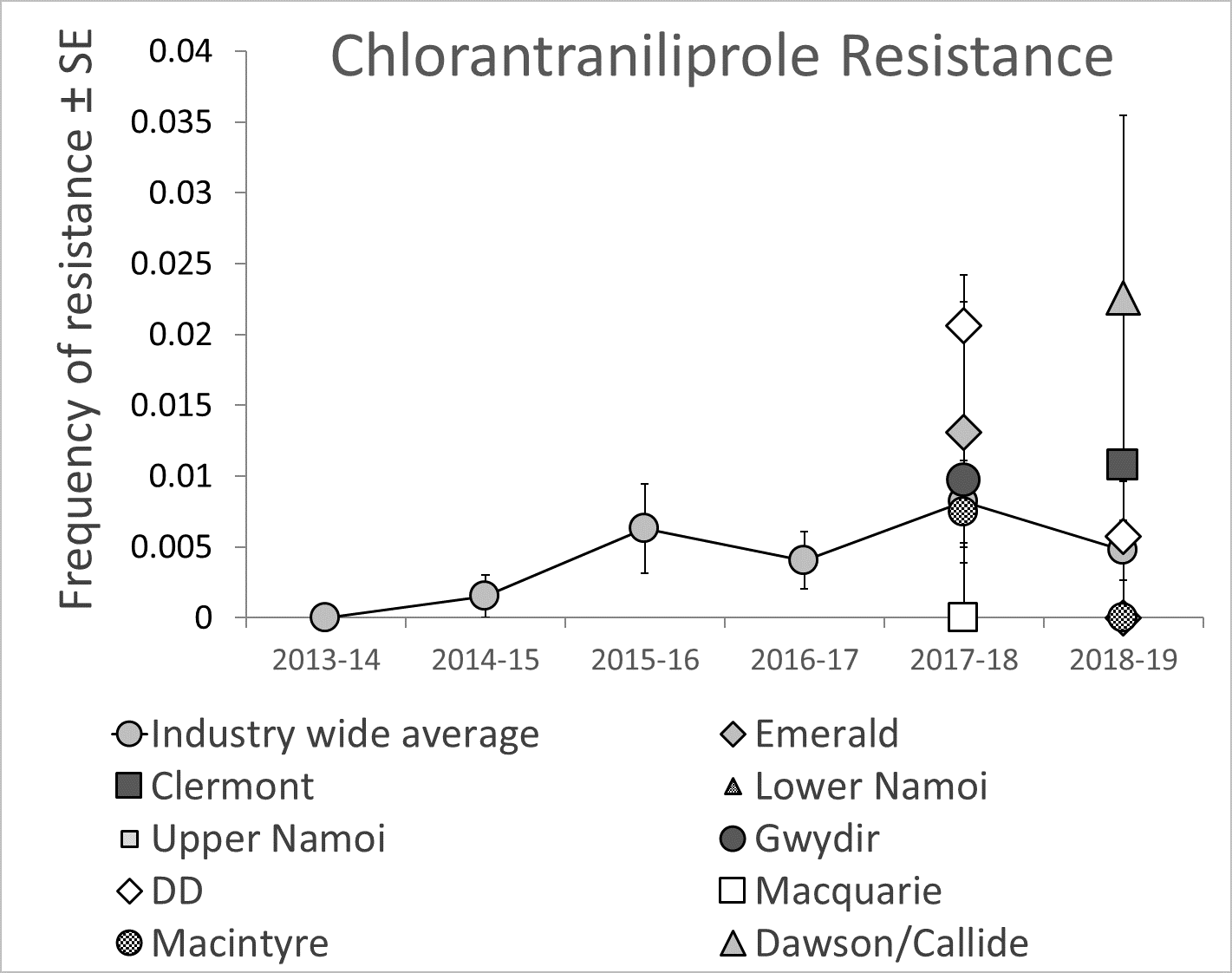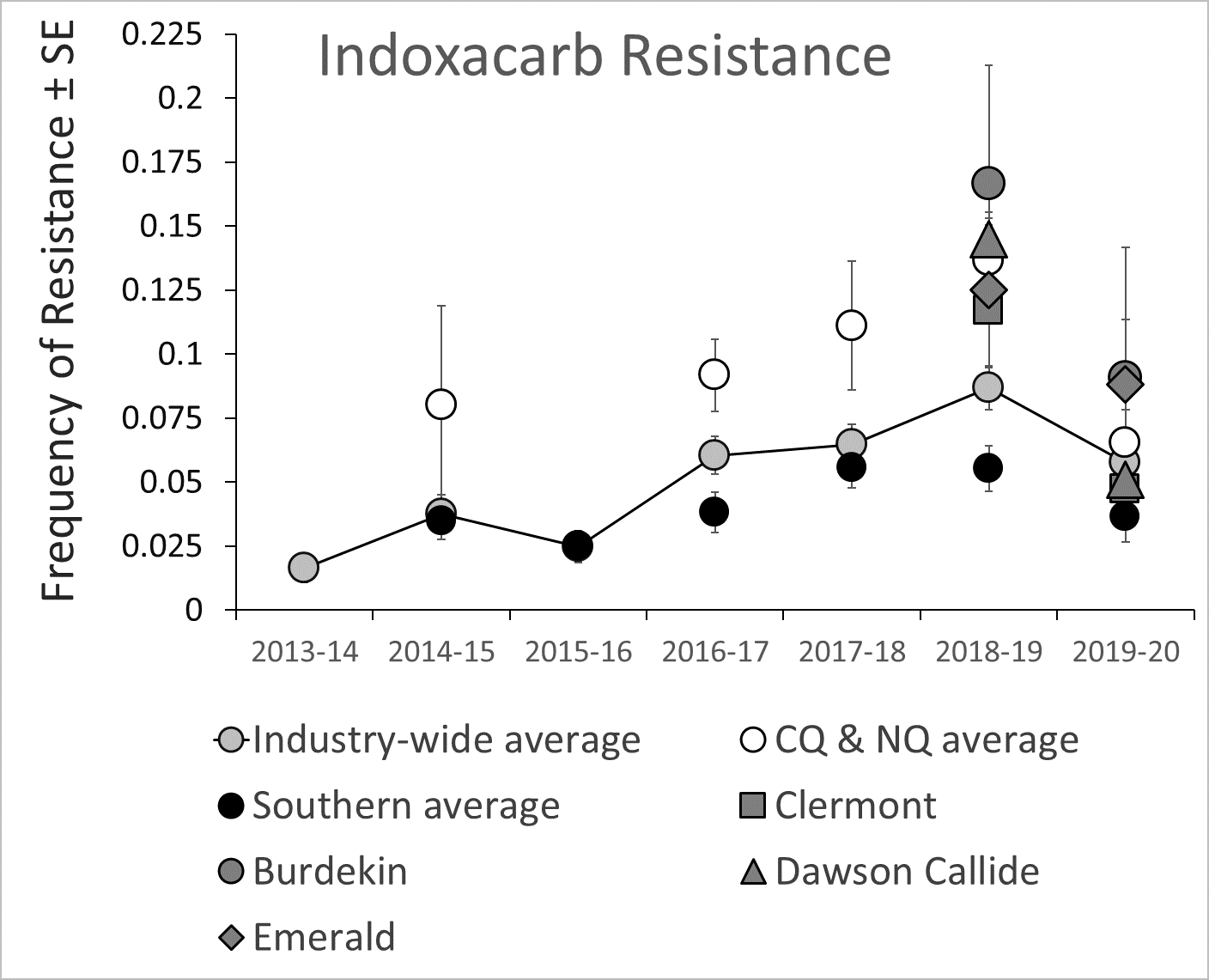Each year NSW Department of Primary Industries conducts a Helicoverpa insecticide resistance surveillance program in the major summer cropping regions of NSW and QLD, focussed on detecting Helicoverpa resistance to the insecticides indoxacarb, emamectin benzoate and chlorantraniliprole.
The program provides growers and advisors with an early warning system for potential resistance hot-spots in the northern region, and is essential for informing ongoing review and improvement of industry-endorsed resistance management strategies..
Resistance levels this season so far compared to previous seasons
Emamectin benzoate
No insects have tested positive for resistance to emamectin benzoate.
Chlorantraniliprole
- Resistance to chlorantraniliprole has remained at about 0.5% on average, but in the past two years there was significantly higher resistance detected in areas of central Queensland (Figure 1).
- So far in 2019-20 samples collected from chickpea fields in central Queensland and mungbean fields in northern Queensland have not had any resistance.

Figure 1. Annual regional frequency of chlorantraniliprole resistance in all regions compared with the eastern Australian average ± binomial standard error (SE).
Indoxacarb
- Resistance to indoxacarb increased significantly in both 2016-17 and 2018-19 (Figure 2), particularly in central and northern QLD where resistance was up to 2.4-fold higher than in the southern regions.
- By the end of the 2018-19 an average of 13.6% of the H. armigera population in central and northern Queensland carried at least one gene for indoxacarb resistance.
- So far in 2019-20 there has been a significant reduction in indoxacarb resistance in samples collected from chickpea fields in central Queensland and mungbean fields in northern Queensland, likely due to reduced plantings of winter pulses as a result of ongoing drought conditions in eastern Australia.
- However, resistance remains slightly higher than the industry average in the Emerald and Burdekin regions (Figure 2).

Figure 2. Annual regional frequency of indoxacarb resistance in central/northern Qld compared with the industry and southern averages ± binomial standard error (SE).
Management implications
H. armigera readily develops resistance in response to selection pressure from insecticides. Currently the risk of resistance to chlorantraniliprole and emamectin benzoate is low, but resistance is likely to increase rapidly if there is over-reliance on these products.
Although indoxacarb resistance has declined in spring cohorts of H. armigera from central and northern Queensland, there is still a high risk for indoxacarb resistance to redevelop.
Indoxacarb and chlorantraniliprole are of particular concern because they are pivotal insecticides across a range of farming systems and are now at increased resistance risk from over-use in the pulse industry.
Ensure that H. armigera is managed to minimise the risk of resistance increasing to levels that could result in spray failures. Refer to the Resistance Management Strategy for best practice product windows and usage restrictions to minimise selection pressure.
Minimise resistance development:
- Regularly monitor pests, natural enemies and spray efficacy
- Calibrate spray-rig for effective coverage
- Choose target-specific products and consider impact on all species present
- Avoid repeated use of the same chemical group, particularly if there is a spray failure
- Comply with all directions on product labels
For more information:
- The GRDC’s resistance management strategy for Helicoverpa armigera is available at IPM Guidelines for Grains.
- Read the paper by Melina Miles and Lisa Bird presented at the recent Goondiwindi GRDC Update: A review of the Helicoverpa Resistance Management Strategy (RMS) after two seasons: what works, what doesn’t, and making it fit for purpose.
- Read about the Helicoverpa insecticide resistance monitoring program in more detail here at the Beatsheet.
